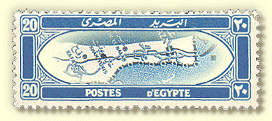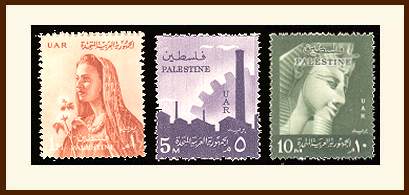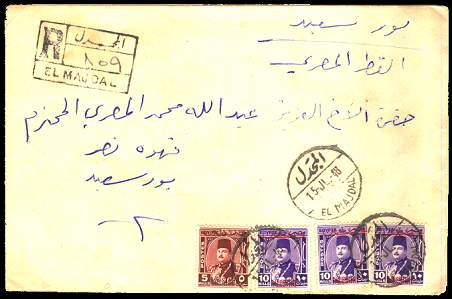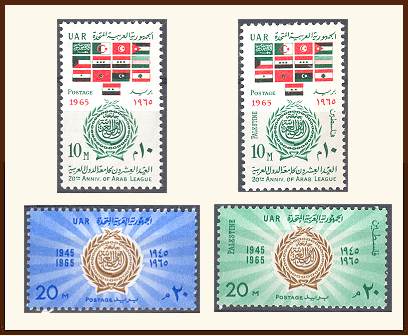

| Denominations: millièmes (m), piastres (p), Egyptian pound (£E) |
| 10m = 1p, 100p = £E1. |
| Stamps for use in the Gaza Strip |
| On May 15, 1948, the first Arab-Israeli war broke out when the forces of the Arab states of Egypt, Iraq, Jordan, Lebanon, Saudi Arabia and Syria crossed their respective borders into what had been the Palestine Mandate. This had been partitioned by the United Nations between the Arab and Jewish inhabitants. The Jews under the leadership of Ben Gurion immediately announced their independence as the state of Israel.
The Arab armies invaded nominally in the name of the Palestinians but as much in fear that another Arab state would grab the land for itself, which in fact is what happened with Jordan taking the greatest spoils and Egypt acquiring the land which has become known as the Gaza Strip. The Egyptian Government, anticipating its capture of parts of Palestine, had overprinted a full range of the current Egyptian adhesives for use in the occupied territories. Egyptian postal facilities were opened in occupied towns - Beer Sheba, Beit Jala, Bethlehem (Beth Lahem), El Majdal, Faluga, Gaza, Hebron, Isdud and Khan Yunis. Overprinted stamps used in all these places are known, although some are quite rare. At the end of the war Egypt retained only the Gaza Strip, which it held until the Six Day War in June 1967, with an interlude in October 1956 when the Israelis held it during the Suez crisis. During this period Egyptian stamps either overprinted “Palestine” or with a colour change and the word “Palestine” incorporated in the design were the only legal usable stamps. They had no validity in Egypt and likewise Egyptian stamps had no validity in the Gaza Strip. In a few circumstances, however, both rules were broken. |
 |
| Various types of the overprints are recognised. For an excellent explanation of these see page 722 of the "Nile Post". |
 |
| At the time of the original overprints Egypt was still a monarchy and several of the
Farouk issues were used, including some of the air stamps, express and postage dues. After the revolution the barred stamps were also overprinted
|
 |
| In 1955 republican issues (above and below) were similarly overprinted. |
 |
| From 1960 the stamps issued for the Gaza Strip were printed specially using the current Egyptian stamps but in different
colours and with the word "Palestine" inscribed in the design, both in English and Arabic (below).
|
 |
 |
| Cover from Majdal, one of the Palestinian towns held by Egyptian troops for only a short while in 1948. Such covers are rare, while those of the Gaza Strip for Gaza and Khan Yunis (1948 to 1967) can be found fairly readily. |
 |
| Palestine stamps can be a happy hunting ground for overprint specialist. Shown above is the 100 millièmes Nefertiti surcharged stamp of January 20, 1959, the leftmost stamp is doubly overprinted with Palestine; the centre example has the surcharge misplaced upward; and that at the right has the surcharge doubled. |
 |
| The overprints have, however, been extensively forged particularly inverted, doubled and in the wrong colour. See above. Not all Egyptian stamps of the period used during overprinting were converted for use in Gaza, so those omitted from official overprinting have attracted the forger's attention. Collectors should beware of offers of any stamps “not in catalogue”, and, worryingly, some of the forgeries have even found their way in to some otherwise respected catalogues. |
 |
| Stamps other than definitives were similarly treated, with postage dues, commemoratives etc. first being issued with overprints and then some reissued with the Arabic and English words for "Palestine" incorporated in the design, usually with distinctive colour changes from the Egypt version. |
 |
| Above (left) is the two-stamp set issued in Egypt on March 25, 1965, to mark the Twentieth Anniversary of the Arab League; and on the right are the Gaza versions, the 10m stamp retaining the same colours with the incorporation of the words "Palestine" while the 20m value also had a change of colour |
 |
| The last stamp to be issued for Gaza - June 1, 1967, Labour Day - just before the Six Day War when Israeli captured the Gaza Strip and the Sinai. At left is the Egyptian stamp; at right its Gaza equivalent with colour change and "Palestine". Israel held Sinai until the peace treaty in the 1980s returned it to Egypt. In the process Egypt renounced all future claims to the Gaza Strip. |
|
|